Understanding and Evaluating Changes in Health and Social Care
VerifiedAdded on 2019/12/03
|14
|4845
|24
Report
AI Summary
This report examines the facilitation of change within health and social care services, using the case of the underperforming Tower Hamlet branch of a nursing home. It explores the key factors driving change, including updated legislation, technological advancements, and rising patient expectations, while also considering external influences through PESTLE analysis. The report then evaluates recent changes, outlining strategies and criteria for measurement, and assesses the impact of these changes on service users. Challenges such as incorporating changes into existing services, managing human and financial resources, security issues, and resistance to change are also addressed. The report also details the principles of change management, adopting Kotter's eight-step model for successful implementation, and assesses how to monitor recent changes in health and social care services. The report concludes by summarizing the key findings and implications for future change management strategies within the health and social care sector.

Facilitating Changes
1
1
Paraphrase This Document
Need a fresh take? Get an instant paraphrase of this document with our AI Paraphraser
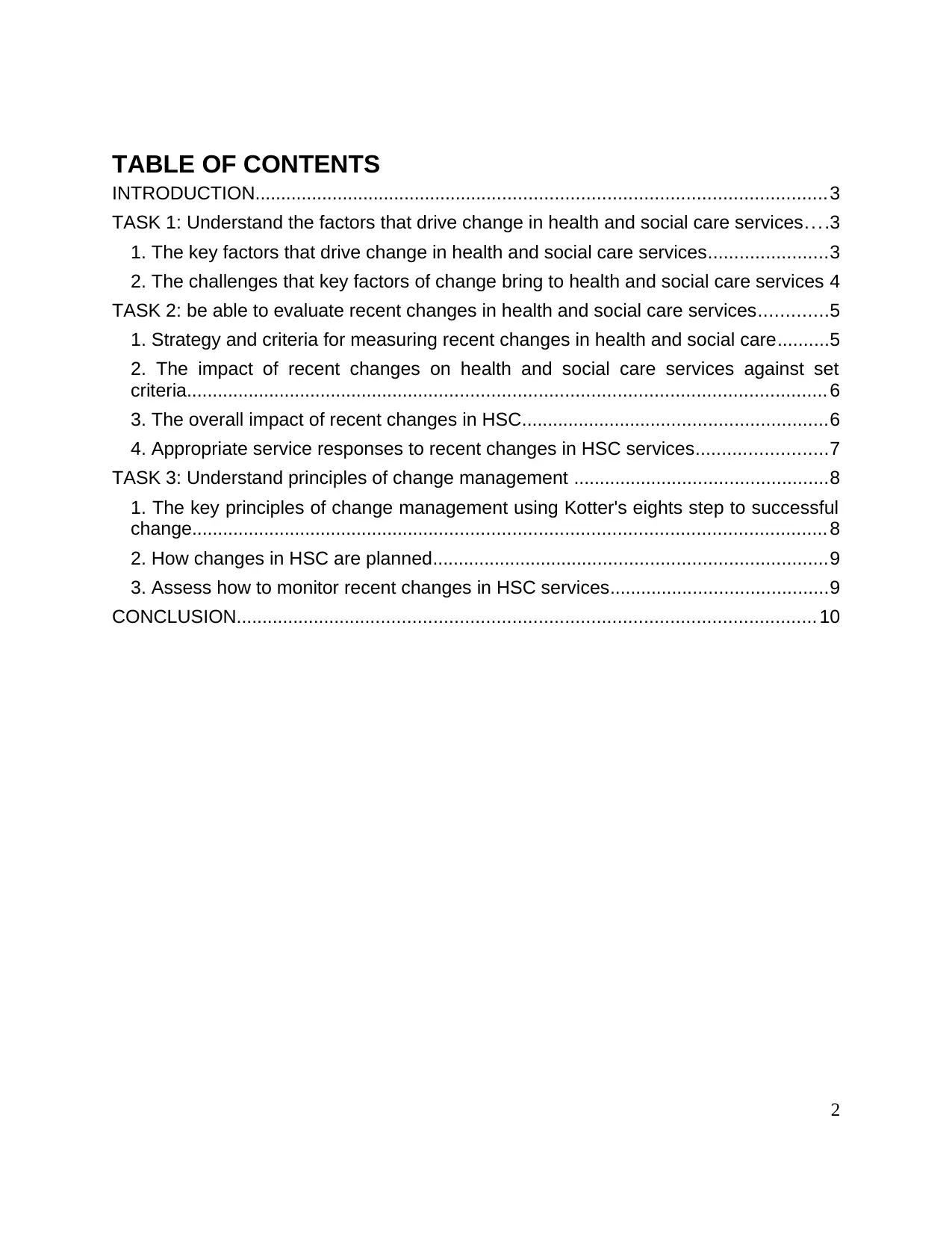
TABLE OF CONTENTS
INTRODUCTION..............................................................................................................3
TASK 1: Understand the factors that drive change in health and social care services....3
1. The key factors that drive change in health and social care services.......................3
2. The challenges that key factors of change bring to health and social care services 4
TASK 2: be able to evaluate recent changes in health and social care services.............5
1. Strategy and criteria for measuring recent changes in health and social care..........5
2. The impact of recent changes on health and social care services against set
criteria........................................................................................................................... 6
3. The overall impact of recent changes in HSC...........................................................6
4. Appropriate service responses to recent changes in HSC services.........................7
TASK 3: Understand principles of change management .................................................8
1. The key principles of change management using Kotter's eights step to successful
change.......................................................................................................................... 8
2. How changes in HSC are planned............................................................................9
3. Assess how to monitor recent changes in HSC services..........................................9
CONCLUSION............................................................................................................... 10
2
INTRODUCTION..............................................................................................................3
TASK 1: Understand the factors that drive change in health and social care services....3
1. The key factors that drive change in health and social care services.......................3
2. The challenges that key factors of change bring to health and social care services 4
TASK 2: be able to evaluate recent changes in health and social care services.............5
1. Strategy and criteria for measuring recent changes in health and social care..........5
2. The impact of recent changes on health and social care services against set
criteria........................................................................................................................... 6
3. The overall impact of recent changes in HSC...........................................................6
4. Appropriate service responses to recent changes in HSC services.........................7
TASK 3: Understand principles of change management .................................................8
1. The key principles of change management using Kotter's eights step to successful
change.......................................................................................................................... 8
2. How changes in HSC are planned............................................................................9
3. Assess how to monitor recent changes in HSC services..........................................9
CONCLUSION............................................................................................................... 10
2
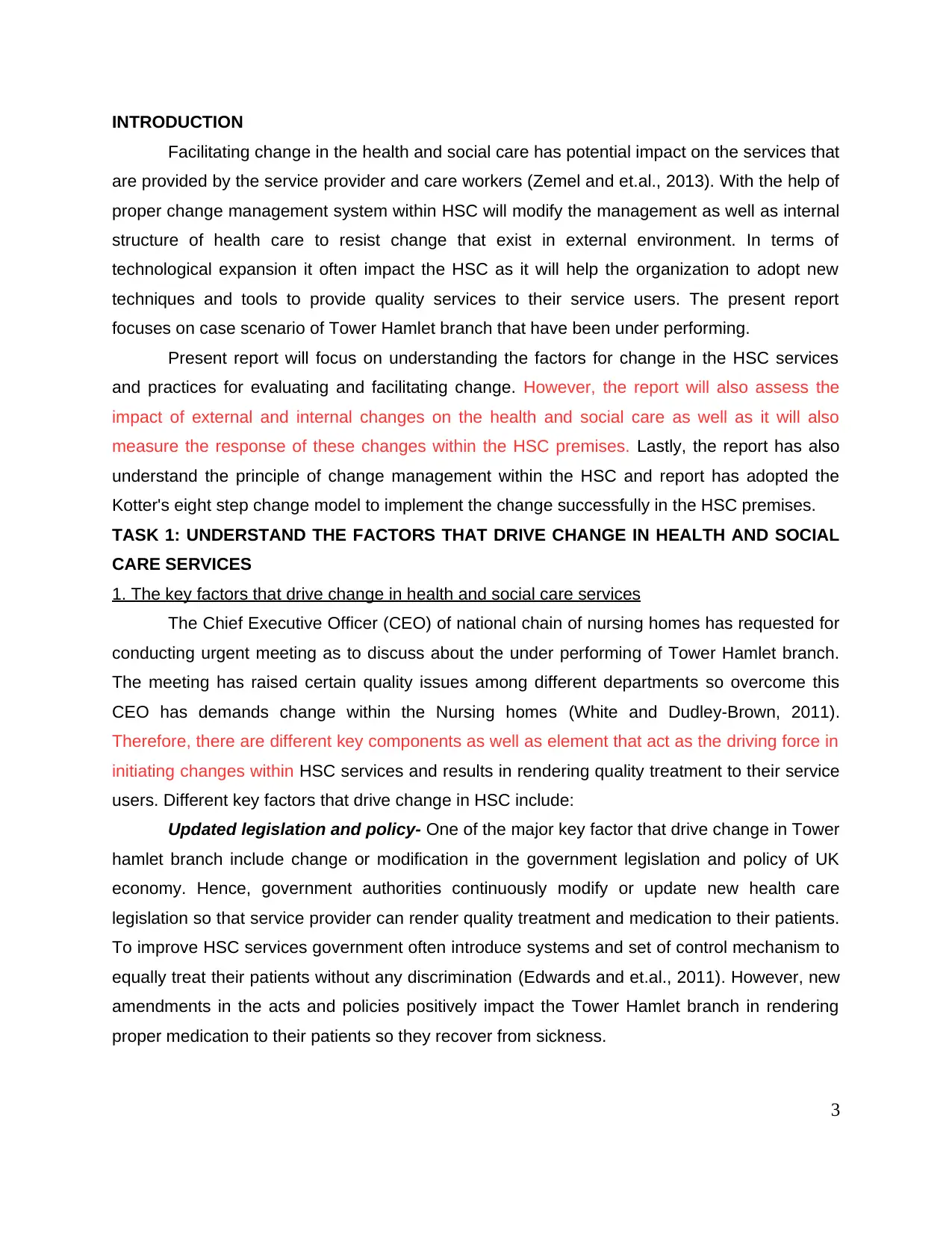
INTRODUCTION
Facilitating change in the health and social care has potential impact on the services that
are provided by the service provider and care workers (Zemel and et.al., 2013). With the help of
proper change management system within HSC will modify the management as well as internal
structure of health care to resist change that exist in external environment. In terms of
technological expansion it often impact the HSC as it will help the organization to adopt new
techniques and tools to provide quality services to their service users. The present report
focuses on case scenario of Tower Hamlet branch that have been under performing.
Present report will focus on understanding the factors for change in the HSC services
and practices for evaluating and facilitating change. However, the report will also assess the
impact of external and internal changes on the health and social care as well as it will also
measure the response of these changes within the HSC premises. Lastly, the report has also
understand the principle of change management within the HSC and report has adopted the
Kotter's eight step change model to implement the change successfully in the HSC premises.
TASK 1: UNDERSTAND THE FACTORS THAT DRIVE CHANGE IN HEALTH AND SOCIAL
CARE SERVICES
1. The key factors that drive change in health and social care services
The Chief Executive Officer (CEO) of national chain of nursing homes has requested for
conducting urgent meeting as to discuss about the under performing of Tower Hamlet branch.
The meeting has raised certain quality issues among different departments so overcome this
CEO has demands change within the Nursing homes (White and Dudley-Brown, 2011).
Therefore, there are different key components as well as element that act as the driving force in
initiating changes within HSC services and results in rendering quality treatment to their service
users. Different key factors that drive change in HSC include:
Updated legislation and policy- One of the major key factor that drive change in Tower
hamlet branch include change or modification in the government legislation and policy of UK
economy. Hence, government authorities continuously modify or update new health care
legislation so that service provider can render quality treatment and medication to their patients.
To improve HSC services government often introduce systems and set of control mechanism to
equally treat their patients without any discrimination (Edwards and et.al., 2011). However, new
amendments in the acts and policies positively impact the Tower Hamlet branch in rendering
proper medication to their patients so they recover from sickness.
3
Facilitating change in the health and social care has potential impact on the services that
are provided by the service provider and care workers (Zemel and et.al., 2013). With the help of
proper change management system within HSC will modify the management as well as internal
structure of health care to resist change that exist in external environment. In terms of
technological expansion it often impact the HSC as it will help the organization to adopt new
techniques and tools to provide quality services to their service users. The present report
focuses on case scenario of Tower Hamlet branch that have been under performing.
Present report will focus on understanding the factors for change in the HSC services
and practices for evaluating and facilitating change. However, the report will also assess the
impact of external and internal changes on the health and social care as well as it will also
measure the response of these changes within the HSC premises. Lastly, the report has also
understand the principle of change management within the HSC and report has adopted the
Kotter's eight step change model to implement the change successfully in the HSC premises.
TASK 1: UNDERSTAND THE FACTORS THAT DRIVE CHANGE IN HEALTH AND SOCIAL
CARE SERVICES
1. The key factors that drive change in health and social care services
The Chief Executive Officer (CEO) of national chain of nursing homes has requested for
conducting urgent meeting as to discuss about the under performing of Tower Hamlet branch.
The meeting has raised certain quality issues among different departments so overcome this
CEO has demands change within the Nursing homes (White and Dudley-Brown, 2011).
Therefore, there are different key components as well as element that act as the driving force in
initiating changes within HSC services and results in rendering quality treatment to their service
users. Different key factors that drive change in HSC include:
Updated legislation and policy- One of the major key factor that drive change in Tower
hamlet branch include change or modification in the government legislation and policy of UK
economy. Hence, government authorities continuously modify or update new health care
legislation so that service provider can render quality treatment and medication to their patients.
To improve HSC services government often introduce systems and set of control mechanism to
equally treat their patients without any discrimination (Edwards and et.al., 2011). However, new
amendments in the acts and policies positively impact the Tower Hamlet branch in rendering
proper medication to their patients so they recover from sickness.
3
⊘ This is a preview!⊘
Do you want full access?
Subscribe today to unlock all pages.

Trusted by 1+ million students worldwide
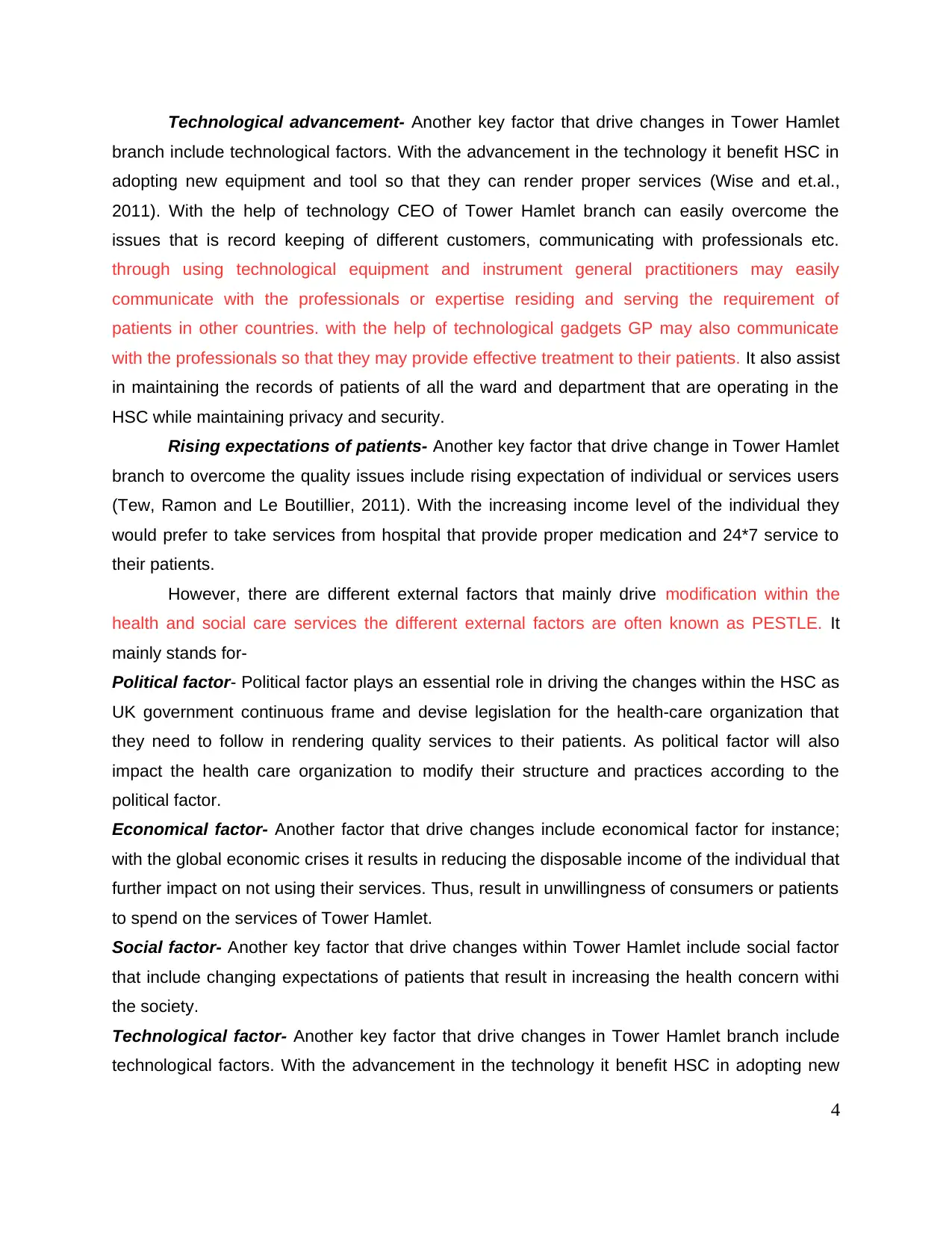
Technological advancement- Another key factor that drive changes in Tower Hamlet
branch include technological factors. With the advancement in the technology it benefit HSC in
adopting new equipment and tool so that they can render proper services (Wise and et.al.,
2011). With the help of technology CEO of Tower Hamlet branch can easily overcome the
issues that is record keeping of different customers, communicating with professionals etc.
through using technological equipment and instrument general practitioners may easily
communicate with the professionals or expertise residing and serving the requirement of
patients in other countries. with the help of technological gadgets GP may also communicate
with the professionals so that they may provide effective treatment to their patients. It also assist
in maintaining the records of patients of all the ward and department that are operating in the
HSC while maintaining privacy and security.
Rising expectations of patients- Another key factor that drive change in Tower Hamlet
branch to overcome the quality issues include rising expectation of individual or services users
(Tew, Ramon and Le Boutillier, 2011). With the increasing income level of the individual they
would prefer to take services from hospital that provide proper medication and 24*7 service to
their patients.
However, there are different external factors that mainly drive modification within the
health and social care services the different external factors are often known as PESTLE. It
mainly stands for-
Political factor- Political factor plays an essential role in driving the changes within the HSC as
UK government continuous frame and devise legislation for the health-care organization that
they need to follow in rendering quality services to their patients. As political factor will also
impact the health care organization to modify their structure and practices according to the
political factor.
Economical factor- Another factor that drive changes include economical factor for instance;
with the global economic crises it results in reducing the disposable income of the individual that
further impact on not using their services. Thus, result in unwillingness of consumers or patients
to spend on the services of Tower Hamlet.
Social factor- Another key factor that drive changes within Tower Hamlet include social factor
that include changing expectations of patients that result in increasing the health concern withi
the society.
Technological factor- Another key factor that drive changes in Tower Hamlet branch include
technological factors. With the advancement in the technology it benefit HSC in adopting new
4
branch include technological factors. With the advancement in the technology it benefit HSC in
adopting new equipment and tool so that they can render proper services (Wise and et.al.,
2011). With the help of technology CEO of Tower Hamlet branch can easily overcome the
issues that is record keeping of different customers, communicating with professionals etc.
through using technological equipment and instrument general practitioners may easily
communicate with the professionals or expertise residing and serving the requirement of
patients in other countries. with the help of technological gadgets GP may also communicate
with the professionals so that they may provide effective treatment to their patients. It also assist
in maintaining the records of patients of all the ward and department that are operating in the
HSC while maintaining privacy and security.
Rising expectations of patients- Another key factor that drive change in Tower Hamlet
branch to overcome the quality issues include rising expectation of individual or services users
(Tew, Ramon and Le Boutillier, 2011). With the increasing income level of the individual they
would prefer to take services from hospital that provide proper medication and 24*7 service to
their patients.
However, there are different external factors that mainly drive modification within the
health and social care services the different external factors are often known as PESTLE. It
mainly stands for-
Political factor- Political factor plays an essential role in driving the changes within the HSC as
UK government continuous frame and devise legislation for the health-care organization that
they need to follow in rendering quality services to their patients. As political factor will also
impact the health care organization to modify their structure and practices according to the
political factor.
Economical factor- Another factor that drive changes include economical factor for instance;
with the global economic crises it results in reducing the disposable income of the individual that
further impact on not using their services. Thus, result in unwillingness of consumers or patients
to spend on the services of Tower Hamlet.
Social factor- Another key factor that drive changes within Tower Hamlet include social factor
that include changing expectations of patients that result in increasing the health concern withi
the society.
Technological factor- Another key factor that drive changes in Tower Hamlet branch include
technological factors. With the advancement in the technology it benefit HSC in adopting new
4
Paraphrase This Document
Need a fresh take? Get an instant paraphrase of this document with our AI Paraphraser
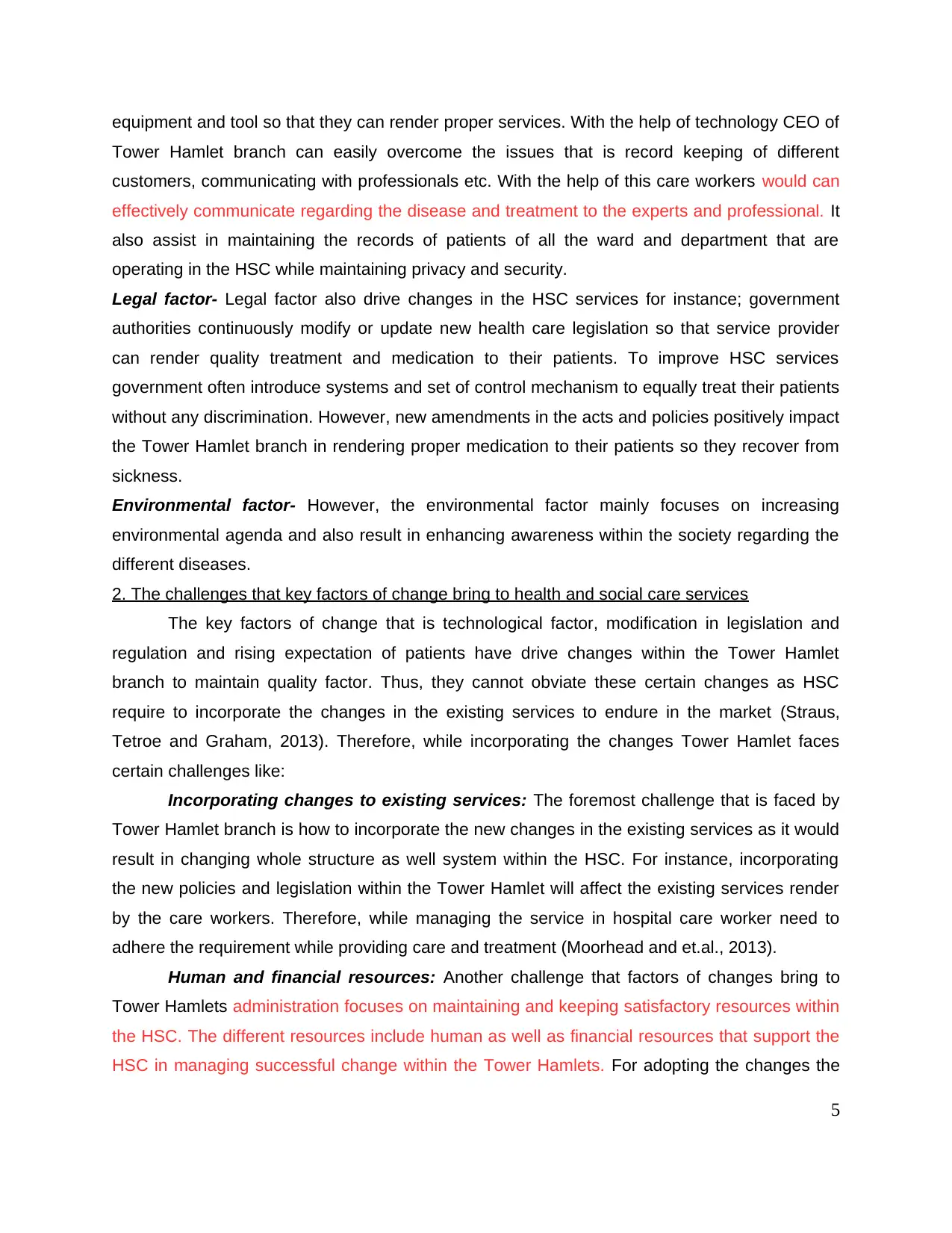
equipment and tool so that they can render proper services. With the help of technology CEO of
Tower Hamlet branch can easily overcome the issues that is record keeping of different
customers, communicating with professionals etc. With the help of this care workers would can
effectively communicate regarding the disease and treatment to the experts and professional. It
also assist in maintaining the records of patients of all the ward and department that are
operating in the HSC while maintaining privacy and security.
Legal factor- Legal factor also drive changes in the HSC services for instance; government
authorities continuously modify or update new health care legislation so that service provider
can render quality treatment and medication to their patients. To improve HSC services
government often introduce systems and set of control mechanism to equally treat their patients
without any discrimination. However, new amendments in the acts and policies positively impact
the Tower Hamlet branch in rendering proper medication to their patients so they recover from
sickness.
Environmental factor- However, the environmental factor mainly focuses on increasing
environmental agenda and also result in enhancing awareness within the society regarding the
different diseases.
2. The challenges that key factors of change bring to health and social care services
The key factors of change that is technological factor, modification in legislation and
regulation and rising expectation of patients have drive changes within the Tower Hamlet
branch to maintain quality factor. Thus, they cannot obviate these certain changes as HSC
require to incorporate the changes in the existing services to endure in the market (Straus,
Tetroe and Graham, 2013). Therefore, while incorporating the changes Tower Hamlet faces
certain challenges like:
Incorporating changes to existing services: The foremost challenge that is faced by
Tower Hamlet branch is how to incorporate the new changes in the existing services as it would
result in changing whole structure as well system within the HSC. For instance, incorporating
the new policies and legislation within the Tower Hamlet will affect the existing services render
by the care workers. Therefore, while managing the service in hospital care worker need to
adhere the requirement while providing care and treatment (Moorhead and et.al., 2013).
Human and financial resources: Another challenge that factors of changes bring to
Tower Hamlets administration focuses on maintaining and keeping satisfactory resources within
the HSC. The different resources include human as well as financial resources that support the
HSC in managing successful change within the Tower Hamlets. For adopting the changes the
5
Tower Hamlet branch can easily overcome the issues that is record keeping of different
customers, communicating with professionals etc. With the help of this care workers would can
effectively communicate regarding the disease and treatment to the experts and professional. It
also assist in maintaining the records of patients of all the ward and department that are
operating in the HSC while maintaining privacy and security.
Legal factor- Legal factor also drive changes in the HSC services for instance; government
authorities continuously modify or update new health care legislation so that service provider
can render quality treatment and medication to their patients. To improve HSC services
government often introduce systems and set of control mechanism to equally treat their patients
without any discrimination. However, new amendments in the acts and policies positively impact
the Tower Hamlet branch in rendering proper medication to their patients so they recover from
sickness.
Environmental factor- However, the environmental factor mainly focuses on increasing
environmental agenda and also result in enhancing awareness within the society regarding the
different diseases.
2. The challenges that key factors of change bring to health and social care services
The key factors of change that is technological factor, modification in legislation and
regulation and rising expectation of patients have drive changes within the Tower Hamlet
branch to maintain quality factor. Thus, they cannot obviate these certain changes as HSC
require to incorporate the changes in the existing services to endure in the market (Straus,
Tetroe and Graham, 2013). Therefore, while incorporating the changes Tower Hamlet faces
certain challenges like:
Incorporating changes to existing services: The foremost challenge that is faced by
Tower Hamlet branch is how to incorporate the new changes in the existing services as it would
result in changing whole structure as well system within the HSC. For instance, incorporating
the new policies and legislation within the Tower Hamlet will affect the existing services render
by the care workers. Therefore, while managing the service in hospital care worker need to
adhere the requirement while providing care and treatment (Moorhead and et.al., 2013).
Human and financial resources: Another challenge that factors of changes bring to
Tower Hamlets administration focuses on maintaining and keeping satisfactory resources within
the HSC. The different resources include human as well as financial resources that support the
HSC in managing successful change within the Tower Hamlets. For adopting the changes the
5
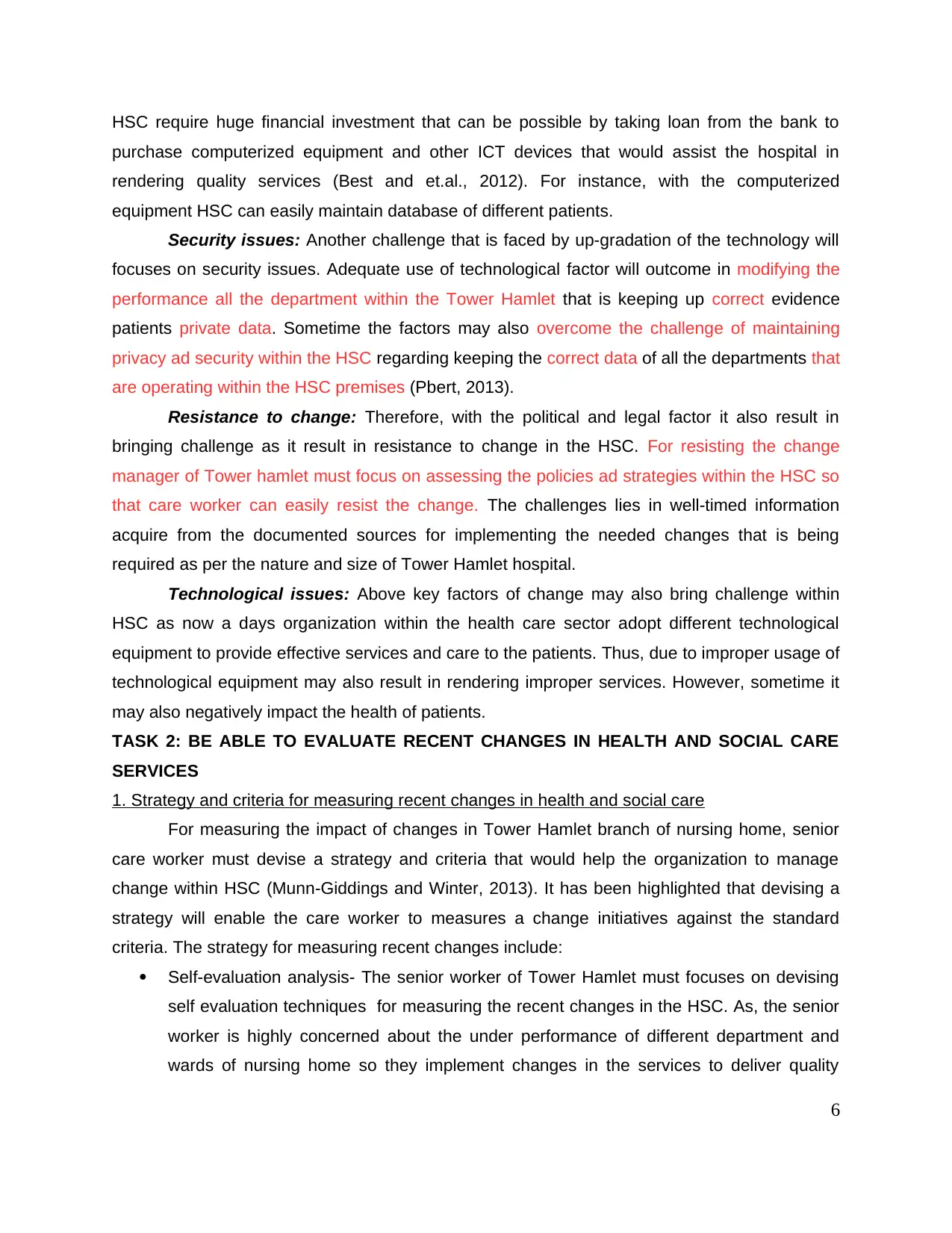
HSC require huge financial investment that can be possible by taking loan from the bank to
purchase computerized equipment and other ICT devices that would assist the hospital in
rendering quality services (Best and et.al., 2012). For instance, with the computerized
equipment HSC can easily maintain database of different patients.
Security issues: Another challenge that is faced by up-gradation of the technology will
focuses on security issues. Adequate use of technological factor will outcome in modifying the
performance all the department within the Tower Hamlet that is keeping up correct evidence
patients private data. Sometime the factors may also overcome the challenge of maintaining
privacy ad security within the HSC regarding keeping the correct data of all the departments that
are operating within the HSC premises (Pbert, 2013).
Resistance to change: Therefore, with the political and legal factor it also result in
bringing challenge as it result in resistance to change in the HSC. For resisting the change
manager of Tower hamlet must focus on assessing the policies ad strategies within the HSC so
that care worker can easily resist the change. The challenges lies in well-timed information
acquire from the documented sources for implementing the needed changes that is being
required as per the nature and size of Tower Hamlet hospital.
Technological issues: Above key factors of change may also bring challenge within
HSC as now a days organization within the health care sector adopt different technological
equipment to provide effective services and care to the patients. Thus, due to improper usage of
technological equipment may also result in rendering improper services. However, sometime it
may also negatively impact the health of patients.
TASK 2: BE ABLE TO EVALUATE RECENT CHANGES IN HEALTH AND SOCIAL CARE
SERVICES
1. Strategy and criteria for measuring recent changes in health and social care
For measuring the impact of changes in Tower Hamlet branch of nursing home, senior
care worker must devise a strategy and criteria that would help the organization to manage
change within HSC (Munn-Giddings and Winter, 2013). It has been highlighted that devising a
strategy will enable the care worker to measures a change initiatives against the standard
criteria. The strategy for measuring recent changes include:
Self-evaluation analysis- The senior worker of Tower Hamlet must focuses on devising
self evaluation techniques for measuring the recent changes in the HSC. As, the senior
worker is highly concerned about the under performance of different department and
wards of nursing home so they implement changes in the services to deliver quality
6
purchase computerized equipment and other ICT devices that would assist the hospital in
rendering quality services (Best and et.al., 2012). For instance, with the computerized
equipment HSC can easily maintain database of different patients.
Security issues: Another challenge that is faced by up-gradation of the technology will
focuses on security issues. Adequate use of technological factor will outcome in modifying the
performance all the department within the Tower Hamlet that is keeping up correct evidence
patients private data. Sometime the factors may also overcome the challenge of maintaining
privacy ad security within the HSC regarding keeping the correct data of all the departments that
are operating within the HSC premises (Pbert, 2013).
Resistance to change: Therefore, with the political and legal factor it also result in
bringing challenge as it result in resistance to change in the HSC. For resisting the change
manager of Tower hamlet must focus on assessing the policies ad strategies within the HSC so
that care worker can easily resist the change. The challenges lies in well-timed information
acquire from the documented sources for implementing the needed changes that is being
required as per the nature and size of Tower Hamlet hospital.
Technological issues: Above key factors of change may also bring challenge within
HSC as now a days organization within the health care sector adopt different technological
equipment to provide effective services and care to the patients. Thus, due to improper usage of
technological equipment may also result in rendering improper services. However, sometime it
may also negatively impact the health of patients.
TASK 2: BE ABLE TO EVALUATE RECENT CHANGES IN HEALTH AND SOCIAL CARE
SERVICES
1. Strategy and criteria for measuring recent changes in health and social care
For measuring the impact of changes in Tower Hamlet branch of nursing home, senior
care worker must devise a strategy and criteria that would help the organization to manage
change within HSC (Munn-Giddings and Winter, 2013). It has been highlighted that devising a
strategy will enable the care worker to measures a change initiatives against the standard
criteria. The strategy for measuring recent changes include:
Self-evaluation analysis- The senior worker of Tower Hamlet must focuses on devising
self evaluation techniques for measuring the recent changes in the HSC. As, the senior
worker is highly concerned about the under performance of different department and
wards of nursing home so they implement changes in the services to deliver quality
6
⊘ This is a preview!⊘
Do you want full access?
Subscribe today to unlock all pages.

Trusted by 1+ million students worldwide

treatment. With the help of using self evaluation strategy senior worker by their own
measures their performance while delivering the services. Senior worker by their own
measures the performance and set standards to succeed in rendering quality services
(Schoenbaum and et. al., 2009).
Regular inspections- With the help of regular inspections senior worker can measures
the impact of recent changes within the HSC and their service provision. Through
regular inspection by CQC agents and different government agencies Tower Hamlet
branch will increase or enhance the performance of their different department by
rendering quality services (Ryan and et. al., 2008).
Criteria for measuring the recent changes include:
Benefit for service users: The effective criteria for measuring the recent changes in the
Tower Hamlet branch is through measuring the benefit that patients gain while
implementing the changes. The quality of treatment or services rendered by the senior
workers can only be explained by the service users or patients including their family.
Thus, positive feedback's and patient discharging within 30 days are foremost way to
measure the improvement (Scott and Spouse, 2013).
2. The impact of recent changes on health and social care services against set criteria
CEO, while focusing on the report during the meeting measures the impact of recent
changes on HSC services against set criteria through following ways that is: Service users and their families- The modification that are enforced in the health
facility may also effect the family members of the patients (Tuomilehto and et. al., 2001).
As the family members are to a great extent depend upon the care worker and the staff
that render the superior aid to the patients. However, the family members cannot stay
with the service users at the every second so, they primarily depend upon the care
practitioners of the health care. Hence, the modification at the workplace or the alteration
in the instrumentation will lead to change the working style of the staff that finally impact
the family members. The family members of the service users completely depend upon
the faculty members of Tower Hamlet branch of nursing home as they cannot stay with
their injured (Watashi and et. al., 2005).
Rising service quality: Moreover, the striking impact of contemporary changes can
also be measured by rising their service quality of treating the patients. By taking
effectual evidence and feedback from the service users and their family members they
should assure the consequence of changes in the Tower Hamlets. The modern changes
7
measures their performance while delivering the services. Senior worker by their own
measures the performance and set standards to succeed in rendering quality services
(Schoenbaum and et. al., 2009).
Regular inspections- With the help of regular inspections senior worker can measures
the impact of recent changes within the HSC and their service provision. Through
regular inspection by CQC agents and different government agencies Tower Hamlet
branch will increase or enhance the performance of their different department by
rendering quality services (Ryan and et. al., 2008).
Criteria for measuring the recent changes include:
Benefit for service users: The effective criteria for measuring the recent changes in the
Tower Hamlet branch is through measuring the benefit that patients gain while
implementing the changes. The quality of treatment or services rendered by the senior
workers can only be explained by the service users or patients including their family.
Thus, positive feedback's and patient discharging within 30 days are foremost way to
measure the improvement (Scott and Spouse, 2013).
2. The impact of recent changes on health and social care services against set criteria
CEO, while focusing on the report during the meeting measures the impact of recent
changes on HSC services against set criteria through following ways that is: Service users and their families- The modification that are enforced in the health
facility may also effect the family members of the patients (Tuomilehto and et. al., 2001).
As the family members are to a great extent depend upon the care worker and the staff
that render the superior aid to the patients. However, the family members cannot stay
with the service users at the every second so, they primarily depend upon the care
practitioners of the health care. Hence, the modification at the workplace or the alteration
in the instrumentation will lead to change the working style of the staff that finally impact
the family members. The family members of the service users completely depend upon
the faculty members of Tower Hamlet branch of nursing home as they cannot stay with
their injured (Watashi and et. al., 2005).
Rising service quality: Moreover, the striking impact of contemporary changes can
also be measured by rising their service quality of treating the patients. By taking
effectual evidence and feedback from the service users and their family members they
should assure the consequence of changes in the Tower Hamlets. The modern changes
7
Paraphrase This Document
Need a fresh take? Get an instant paraphrase of this document with our AI Paraphraser
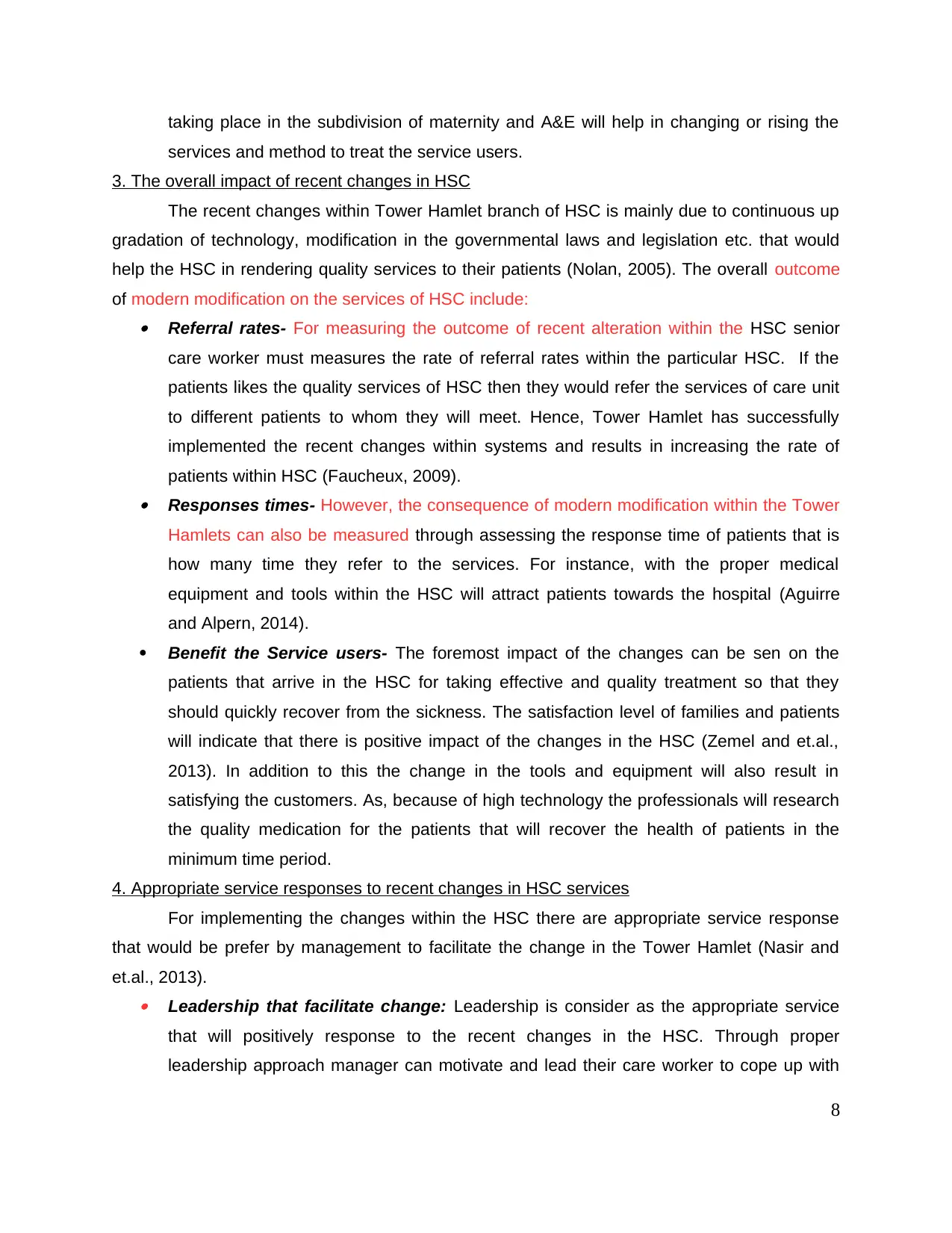
taking place in the subdivision of maternity and A&E will help in changing or rising the
services and method to treat the service users.
3. The overall impact of recent changes in HSC
The recent changes within Tower Hamlet branch of HSC is mainly due to continuous up
gradation of technology, modification in the governmental laws and legislation etc. that would
help the HSC in rendering quality services to their patients (Nolan, 2005). The overall outcome
of modern modification on the services of HSC include: Referral rates- For measuring the outcome of recent alteration within the HSC senior
care worker must measures the rate of referral rates within the particular HSC. If the
patients likes the quality services of HSC then they would refer the services of care unit
to different patients to whom they will meet. Hence, Tower Hamlet has successfully
implemented the recent changes within systems and results in increasing the rate of
patients within HSC (Faucheux, 2009). Responses times- However, the consequence of modern modification within the Tower
Hamlets can also be measured through assessing the response time of patients that is
how many time they refer to the services. For instance, with the proper medical
equipment and tools within the HSC will attract patients towards the hospital (Aguirre
and Alpern, 2014).
Benefit the Service users- The foremost impact of the changes can be sen on the
patients that arrive in the HSC for taking effective and quality treatment so that they
should quickly recover from the sickness. The satisfaction level of families and patients
will indicate that there is positive impact of the changes in the HSC (Zemel and et.al.,
2013). In addition to this the change in the tools and equipment will also result in
satisfying the customers. As, because of high technology the professionals will research
the quality medication for the patients that will recover the health of patients in the
minimum time period.
4. Appropriate service responses to recent changes in HSC services
For implementing the changes within the HSC there are appropriate service response
that would be prefer by management to facilitate the change in the Tower Hamlet (Nasir and
et.al., 2013). Leadership that facilitate change: Leadership is consider as the appropriate service
that will positively response to the recent changes in the HSC. Through proper
leadership approach manager can motivate and lead their care worker to cope up with
8
services and method to treat the service users.
3. The overall impact of recent changes in HSC
The recent changes within Tower Hamlet branch of HSC is mainly due to continuous up
gradation of technology, modification in the governmental laws and legislation etc. that would
help the HSC in rendering quality services to their patients (Nolan, 2005). The overall outcome
of modern modification on the services of HSC include: Referral rates- For measuring the outcome of recent alteration within the HSC senior
care worker must measures the rate of referral rates within the particular HSC. If the
patients likes the quality services of HSC then they would refer the services of care unit
to different patients to whom they will meet. Hence, Tower Hamlet has successfully
implemented the recent changes within systems and results in increasing the rate of
patients within HSC (Faucheux, 2009). Responses times- However, the consequence of modern modification within the Tower
Hamlets can also be measured through assessing the response time of patients that is
how many time they refer to the services. For instance, with the proper medical
equipment and tools within the HSC will attract patients towards the hospital (Aguirre
and Alpern, 2014).
Benefit the Service users- The foremost impact of the changes can be sen on the
patients that arrive in the HSC for taking effective and quality treatment so that they
should quickly recover from the sickness. The satisfaction level of families and patients
will indicate that there is positive impact of the changes in the HSC (Zemel and et.al.,
2013). In addition to this the change in the tools and equipment will also result in
satisfying the customers. As, because of high technology the professionals will research
the quality medication for the patients that will recover the health of patients in the
minimum time period.
4. Appropriate service responses to recent changes in HSC services
For implementing the changes within the HSC there are appropriate service response
that would be prefer by management to facilitate the change in the Tower Hamlet (Nasir and
et.al., 2013). Leadership that facilitate change: Leadership is consider as the appropriate service
that will positively response to the recent changes in the HSC. Through proper
leadership approach manager can motivate and lead their care worker to cope up with
8
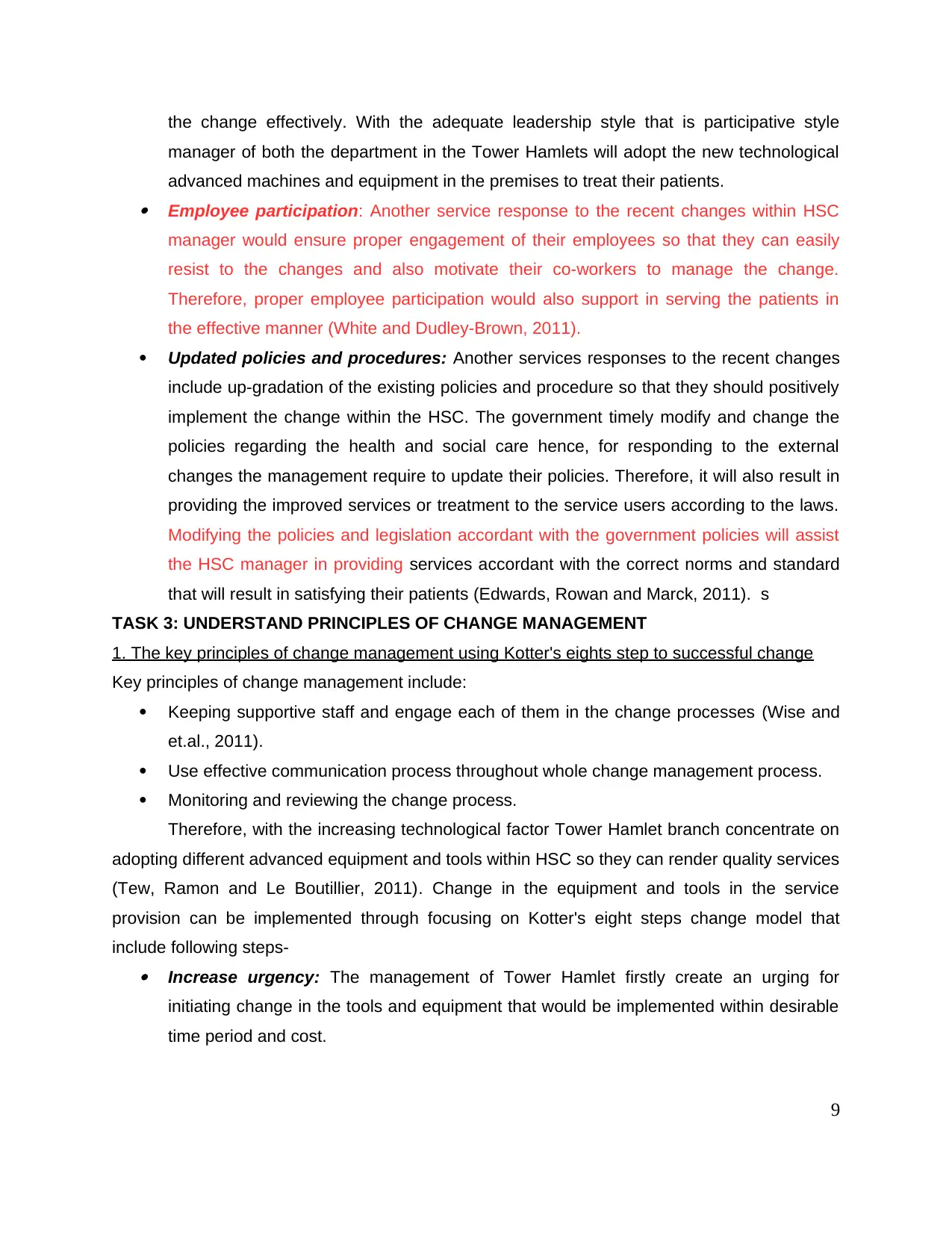
the change effectively. With the adequate leadership style that is participative style
manager of both the department in the Tower Hamlets will adopt the new technological
advanced machines and equipment in the premises to treat their patients. Employee participation: Another service response to the recent changes within HSC
manager would ensure proper engagement of their employees so that they can easily
resist to the changes and also motivate their co-workers to manage the change.
Therefore, proper employee participation would also support in serving the patients in
the effective manner (White and Dudley-Brown, 2011).
Updated policies and procedures: Another services responses to the recent changes
include up-gradation of the existing policies and procedure so that they should positively
implement the change within the HSC. The government timely modify and change the
policies regarding the health and social care hence, for responding to the external
changes the management require to update their policies. Therefore, it will also result in
providing the improved services or treatment to the service users according to the laws.
Modifying the policies and legislation accordant with the government policies will assist
the HSC manager in providing services accordant with the correct norms and standard
that will result in satisfying their patients (Edwards, Rowan and Marck, 2011). s
TASK 3: UNDERSTAND PRINCIPLES OF CHANGE MANAGEMENT
1. The key principles of change management using Kotter's eights step to successful change
Key principles of change management include:
Keeping supportive staff and engage each of them in the change processes (Wise and
et.al., 2011).
Use effective communication process throughout whole change management process.
Monitoring and reviewing the change process.
Therefore, with the increasing technological factor Tower Hamlet branch concentrate on
adopting different advanced equipment and tools within HSC so they can render quality services
(Tew, Ramon and Le Boutillier, 2011). Change in the equipment and tools in the service
provision can be implemented through focusing on Kotter's eight steps change model that
include following steps- Increase urgency: The management of Tower Hamlet firstly create an urging for
initiating change in the tools and equipment that would be implemented within desirable
time period and cost.
9
manager of both the department in the Tower Hamlets will adopt the new technological
advanced machines and equipment in the premises to treat their patients. Employee participation: Another service response to the recent changes within HSC
manager would ensure proper engagement of their employees so that they can easily
resist to the changes and also motivate their co-workers to manage the change.
Therefore, proper employee participation would also support in serving the patients in
the effective manner (White and Dudley-Brown, 2011).
Updated policies and procedures: Another services responses to the recent changes
include up-gradation of the existing policies and procedure so that they should positively
implement the change within the HSC. The government timely modify and change the
policies regarding the health and social care hence, for responding to the external
changes the management require to update their policies. Therefore, it will also result in
providing the improved services or treatment to the service users according to the laws.
Modifying the policies and legislation accordant with the government policies will assist
the HSC manager in providing services accordant with the correct norms and standard
that will result in satisfying their patients (Edwards, Rowan and Marck, 2011). s
TASK 3: UNDERSTAND PRINCIPLES OF CHANGE MANAGEMENT
1. The key principles of change management using Kotter's eights step to successful change
Key principles of change management include:
Keeping supportive staff and engage each of them in the change processes (Wise and
et.al., 2011).
Use effective communication process throughout whole change management process.
Monitoring and reviewing the change process.
Therefore, with the increasing technological factor Tower Hamlet branch concentrate on
adopting different advanced equipment and tools within HSC so they can render quality services
(Tew, Ramon and Le Boutillier, 2011). Change in the equipment and tools in the service
provision can be implemented through focusing on Kotter's eight steps change model that
include following steps- Increase urgency: The management of Tower Hamlet firstly create an urging for
initiating change in the tools and equipment that would be implemented within desirable
time period and cost.
9
⊘ This is a preview!⊘
Do you want full access?
Subscribe today to unlock all pages.

Trusted by 1+ million students worldwide
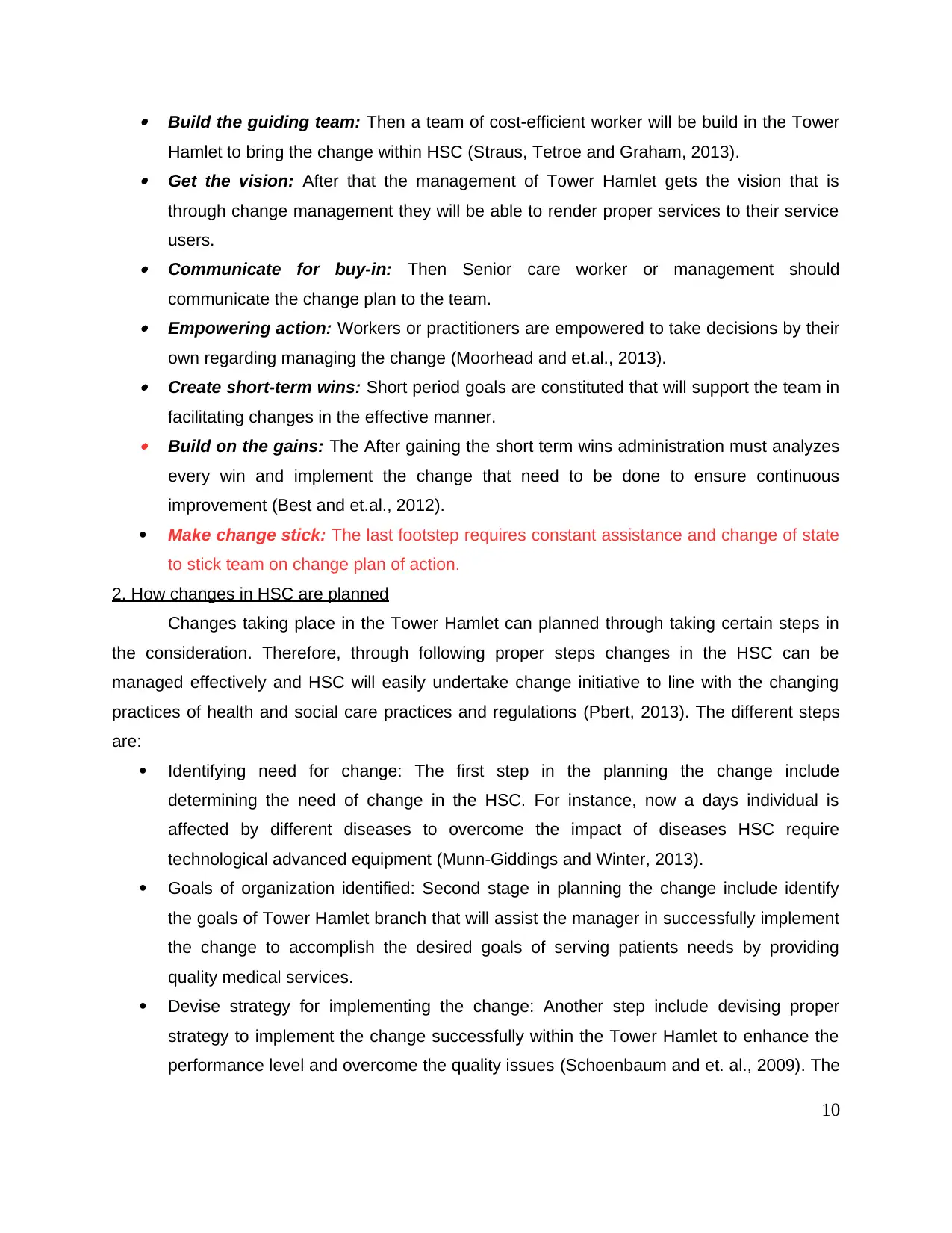
Build the guiding team: Then a team of cost-efficient worker will be build in the Tower
Hamlet to bring the change within HSC (Straus, Tetroe and Graham, 2013). Get the vision: After that the management of Tower Hamlet gets the vision that is
through change management they will be able to render proper services to their service
users. Communicate for buy-in: Then Senior care worker or management should
communicate the change plan to the team. Empowering action: Workers or practitioners are empowered to take decisions by their
own regarding managing the change (Moorhead and et.al., 2013). Create short-term wins: Short period goals are constituted that will support the team in
facilitating changes in the effective manner. Build on the gains: The After gaining the short term wins administration must analyzes
every win and implement the change that need to be done to ensure continuous
improvement (Best and et.al., 2012).
Make change stick: The last footstep requires constant assistance and change of state
to stick team on change plan of action.
2. How changes in HSC are planned
Changes taking place in the Tower Hamlet can planned through taking certain steps in
the consideration. Therefore, through following proper steps changes in the HSC can be
managed effectively and HSC will easily undertake change initiative to line with the changing
practices of health and social care practices and regulations (Pbert, 2013). The different steps
are:
Identifying need for change: The first step in the planning the change include
determining the need of change in the HSC. For instance, now a days individual is
affected by different diseases to overcome the impact of diseases HSC require
technological advanced equipment (Munn-Giddings and Winter, 2013).
Goals of organization identified: Second stage in planning the change include identify
the goals of Tower Hamlet branch that will assist the manager in successfully implement
the change to accomplish the desired goals of serving patients needs by providing
quality medical services.
Devise strategy for implementing the change: Another step include devising proper
strategy to implement the change successfully within the Tower Hamlet to enhance the
performance level and overcome the quality issues (Schoenbaum and et. al., 2009). The
10
Hamlet to bring the change within HSC (Straus, Tetroe and Graham, 2013). Get the vision: After that the management of Tower Hamlet gets the vision that is
through change management they will be able to render proper services to their service
users. Communicate for buy-in: Then Senior care worker or management should
communicate the change plan to the team. Empowering action: Workers or practitioners are empowered to take decisions by their
own regarding managing the change (Moorhead and et.al., 2013). Create short-term wins: Short period goals are constituted that will support the team in
facilitating changes in the effective manner. Build on the gains: The After gaining the short term wins administration must analyzes
every win and implement the change that need to be done to ensure continuous
improvement (Best and et.al., 2012).
Make change stick: The last footstep requires constant assistance and change of state
to stick team on change plan of action.
2. How changes in HSC are planned
Changes taking place in the Tower Hamlet can planned through taking certain steps in
the consideration. Therefore, through following proper steps changes in the HSC can be
managed effectively and HSC will easily undertake change initiative to line with the changing
practices of health and social care practices and regulations (Pbert, 2013). The different steps
are:
Identifying need for change: The first step in the planning the change include
determining the need of change in the HSC. For instance, now a days individual is
affected by different diseases to overcome the impact of diseases HSC require
technological advanced equipment (Munn-Giddings and Winter, 2013).
Goals of organization identified: Second stage in planning the change include identify
the goals of Tower Hamlet branch that will assist the manager in successfully implement
the change to accomplish the desired goals of serving patients needs by providing
quality medical services.
Devise strategy for implementing the change: Another step include devising proper
strategy to implement the change successfully within the Tower Hamlet to enhance the
performance level and overcome the quality issues (Schoenbaum and et. al., 2009). The
10
Paraphrase This Document
Need a fresh take? Get an instant paraphrase of this document with our AI Paraphraser
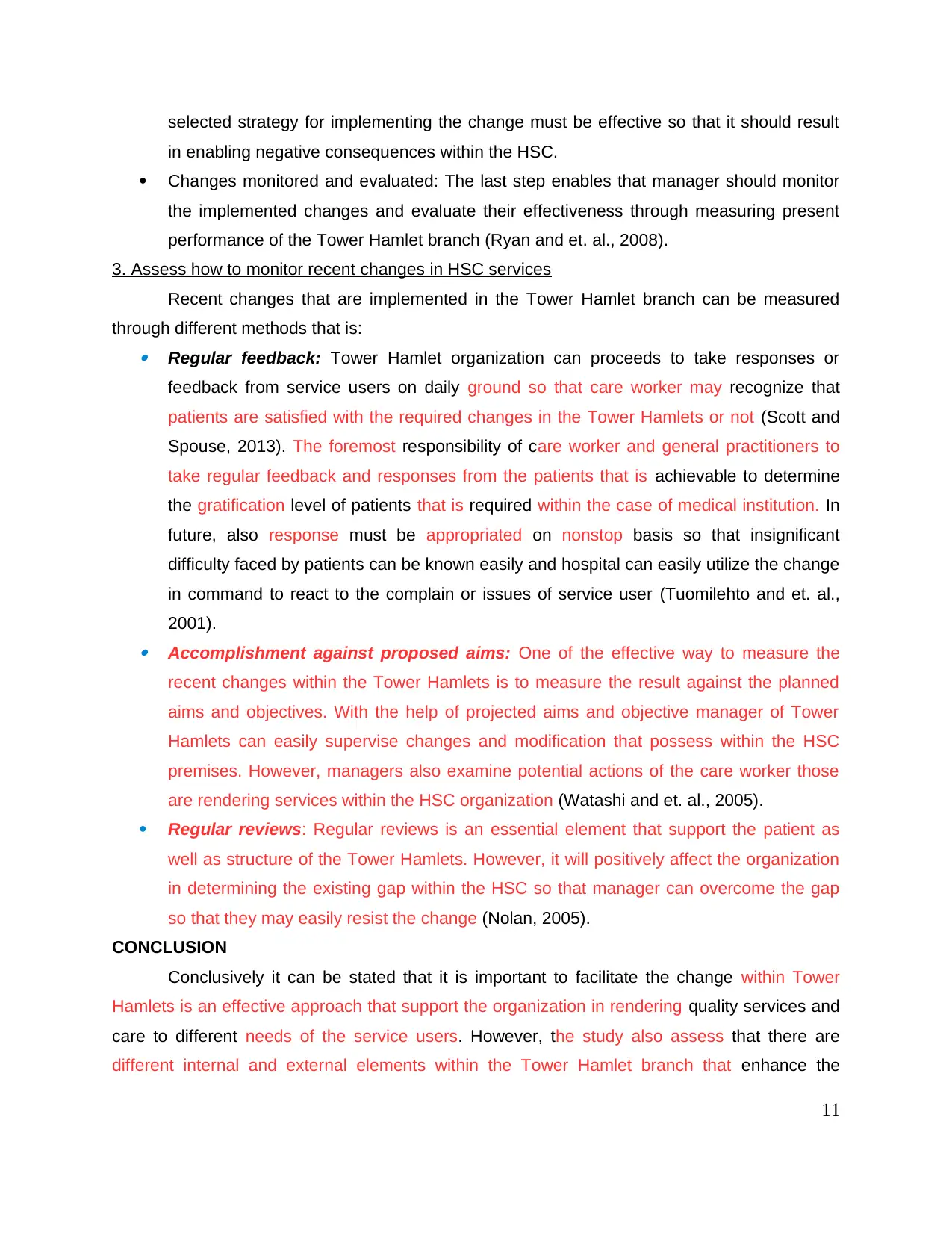
selected strategy for implementing the change must be effective so that it should result
in enabling negative consequences within the HSC.
Changes monitored and evaluated: The last step enables that manager should monitor
the implemented changes and evaluate their effectiveness through measuring present
performance of the Tower Hamlet branch (Ryan and et. al., 2008).
3. Assess how to monitor recent changes in HSC services
Recent changes that are implemented in the Tower Hamlet branch can be measured
through different methods that is: Regular feedback: Tower Hamlet organization can proceeds to take responses or
feedback from service users on daily ground so that care worker may recognize that
patients are satisfied with the required changes in the Tower Hamlets or not (Scott and
Spouse, 2013). The foremost responsibility of care worker and general practitioners to
take regular feedback and responses from the patients that is achievable to determine
the gratification level of patients that is required within the case of medical institution. In
future, also response must be appropriated on nonstop basis so that insignificant
difficulty faced by patients can be known easily and hospital can easily utilize the change
in command to react to the complain or issues of service user (Tuomilehto and et. al.,
2001). Accomplishment against proposed aims: One of the effective way to measure the
recent changes within the Tower Hamlets is to measure the result against the planned
aims and objectives. With the help of projected aims and objective manager of Tower
Hamlets can easily supervise changes and modification that possess within the HSC
premises. However, managers also examine potential actions of the care worker those
are rendering services within the HSC organization (Watashi and et. al., 2005).
Regular reviews: Regular reviews is an essential element that support the patient as
well as structure of the Tower Hamlets. However, it will positively affect the organization
in determining the existing gap within the HSC so that manager can overcome the gap
so that they may easily resist the change (Nolan, 2005).
CONCLUSION
Conclusively it can be stated that it is important to facilitate the change within Tower
Hamlets is an effective approach that support the organization in rendering quality services and
care to different needs of the service users. However, the study also assess that there are
different internal and external elements within the Tower Hamlet branch that enhance the
11
in enabling negative consequences within the HSC.
Changes monitored and evaluated: The last step enables that manager should monitor
the implemented changes and evaluate their effectiveness through measuring present
performance of the Tower Hamlet branch (Ryan and et. al., 2008).
3. Assess how to monitor recent changes in HSC services
Recent changes that are implemented in the Tower Hamlet branch can be measured
through different methods that is: Regular feedback: Tower Hamlet organization can proceeds to take responses or
feedback from service users on daily ground so that care worker may recognize that
patients are satisfied with the required changes in the Tower Hamlets or not (Scott and
Spouse, 2013). The foremost responsibility of care worker and general practitioners to
take regular feedback and responses from the patients that is achievable to determine
the gratification level of patients that is required within the case of medical institution. In
future, also response must be appropriated on nonstop basis so that insignificant
difficulty faced by patients can be known easily and hospital can easily utilize the change
in command to react to the complain or issues of service user (Tuomilehto and et. al.,
2001). Accomplishment against proposed aims: One of the effective way to measure the
recent changes within the Tower Hamlets is to measure the result against the planned
aims and objectives. With the help of projected aims and objective manager of Tower
Hamlets can easily supervise changes and modification that possess within the HSC
premises. However, managers also examine potential actions of the care worker those
are rendering services within the HSC organization (Watashi and et. al., 2005).
Regular reviews: Regular reviews is an essential element that support the patient as
well as structure of the Tower Hamlets. However, it will positively affect the organization
in determining the existing gap within the HSC so that manager can overcome the gap
so that they may easily resist the change (Nolan, 2005).
CONCLUSION
Conclusively it can be stated that it is important to facilitate the change within Tower
Hamlets is an effective approach that support the organization in rendering quality services and
care to different needs of the service users. However, the study also assess that there are
different internal and external elements within the Tower Hamlet branch that enhance the
11

performance of their department and raise quality among the services. However, the report has
also suggested that through implementing the change in the HSC they have assess certain
challenges like security issues etc. The report has also devise a plan of action and criteria for
evaluating the impact of modern changes in the HSC. Lastly, the report has also understand the
principle of change management within the HSC and report has adopted the Kotter's eight step
change model to implement the change successfully in the HSC premises.
12
also suggested that through implementing the change in the HSC they have assess certain
challenges like security issues etc. The report has also devise a plan of action and criteria for
evaluating the impact of modern changes in the HSC. Lastly, the report has also understand the
principle of change management within the HSC and report has adopted the Kotter's eight step
change model to implement the change successfully in the HSC premises.
12
⊘ This is a preview!⊘
Do you want full access?
Subscribe today to unlock all pages.

Trusted by 1+ million students worldwide
1 out of 14
Related Documents
Your All-in-One AI-Powered Toolkit for Academic Success.
+13062052269
info@desklib.com
Available 24*7 on WhatsApp / Email
![[object Object]](/_next/static/media/star-bottom.7253800d.svg)
Unlock your academic potential
Copyright © 2020–2025 A2Z Services. All Rights Reserved. Developed and managed by ZUCOL.




